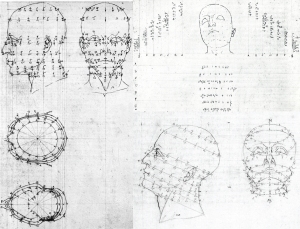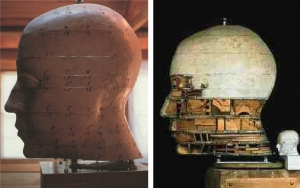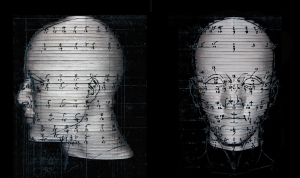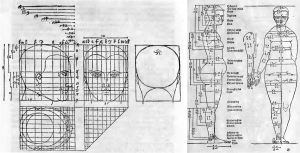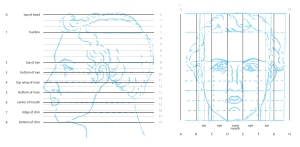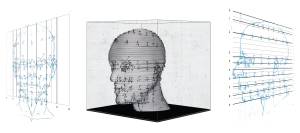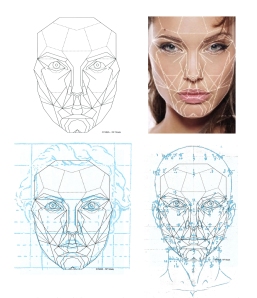Inspired by Leonardo’s drawing of the Vitruvian man, I became interested in the study of human proportion and its evolution over the Renaissance Era. I focused my research by comparing the work of two Renaissance artists, Piero Della Francesca and Albrecht Durer.
In Piero’s manuscript entitled De Prospectiva Pingendi (On the Perspective for Painting) written between 1474 and 1482, he produces a drawing of the human head entitled Elevations and Horizontal Outlines of the Human Head. Through this drawing he attempted to realize the ideal proportions of the human head through significant geometrical and cosmological numbers. His drawing consists of two groups of four sectional plans; radially divided into sixteen sections and two elevations; horizontally segregated into 8 parts. He intersected these two drawings to plot a series of data points on a polar coordinate grid. Through orthographic projection, used these points to reorient and draw the head at any angle. This surveying technique is very similar to that of Alberti in his map of Rome, which Alberti describes by saying, “The man who possesses them [the numbers] can so record the outlines and position and arrangement of the parts of any given body in accurate and absolutely reliably written forms that not merely a day later, but even after a whole cycle of the heavens, he can again at will situate and arrange the same body.”(Smedley 2001)
In 2001, artist Geoffrey Smedley showcased his work at an exhibition put on at the Canadian Centre for Architecture entitled Meditations on Piero. His work consisted of a series of drawings and sculptural meditations based on Piero’s drawings of the human head. His study engaged concepts of cosmology, perspective, anatomy and surveying, apparent in Piero’s work. In one of his models entitled The Numbers, Smedley constructed a sculpture that consisted of nine horizontal surfaces, which carefully follows Piero’s mapping of the head. This inspired me to construct a model as a way to materialize my own interpretation of Piero’s drawing.
Albrecht Durer’s theory of human proportion derived from the geometrical canon that Leonardo used to construct the Vitruvian man. Durer did not generalize man through idealized proportions, rather recognized the immense diversity of the human form that existed in society. In his book entitled Four Books on Human Proportion he states, “If you wish to make a beautiful figure, it is necessary that you probe the nature and proportions of many people: a head from one; a breast, arm, leg from another.”( Durer 2003) To create the drawings illustrated in this book, he first defines a system of geometrical measure. He then adjusts this system using relative proportion and fractional relations to conform to different body types. His system divides the profile of the head into eight sections and front of the head into seven.
Through the imposition of Durer’s system on Piero’s head I found that their divisions were essentially the same, excluding the addition of one division line between the top of the head and the top of the hairline in Piero’s drawing. Durer also applied his method of drawing perspective as a way to reorganize the grid to draw different orientations of the head.
A modern exploration by Stephan Marquardt featured in a four-part BBC documentary entitled The Human Face, examines beauty in reference to symmetrical proportions. He used to the golden ratio to create a mask known as the Golden Mast, which he claims encapsulates absolute, universal beauty. He explains his view by stating, “the closer the face conforms to this mask, the more beautiful it is.” (Human Head, BBC One 2001)
References:
“Albrecht Durer: 1471-1528.” The Metropolitan Museum of Art. 2000-2012 <http://www.metmuseum.org/toah/hd/durr/hd_durr.htm>
“Collections: Printed Books & Bindings.” The Morgan Library & Museum. New York. <http://www.themorgan.org/collections/collections.asp?id=577>.
Dodds, George., Tavernor, Robert., Rykwert, Joseph. “Body and Building: Essays on the Changing Relation of Body and Architecture.” Massachusetts: Massachusetts Institute of Technology, 2001.
Durer, Albrecht. “De symmetria partium in rectis formis humanorum corporum : Nuremberg.” 1532 Oakland: Octavo Corp, 2003.
Field, J.“Piero Della Francesca: A Mathematician’s Art.”London, 2005
Franscesca, D. Piero. De Prospectiva Pingendi. Firenze: Casa Editrice Le Lettre, 1984.
Gates, H. William. The Art of Drawing The Human Figure. London: Bailliere, Tindall and Cox.
Neher, Allister. “Albrecht Durrer and Nicholas Suanus: the Real, the Ideal, and the Quantification of the Body.” Luxemburg: Jean-Paul Riopelle, 1992. <http://www.uqtr.uquebec.ca/AE/Vol_11/libre/Neher.htm>
Human Head. Dir. Erskine, James., Stewart, David. BBC One, 2001.
Smedley, Geoffrey. Meditations on Piero: Sculptures by Geoffrey Smedley. Montreal: Centre Canadien d’Architecture/Canadian Centre for Architecture, 2001.
Williams, Kim., Lionel, March., Wassel, Stephen., “The Mathematical Works of Leon Battista Alberti.” Washington: Birkhauser, 2010.
